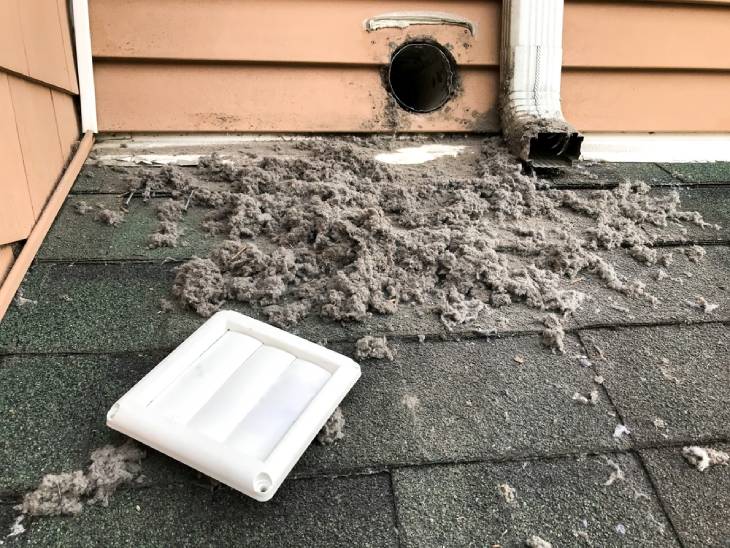
Laundry day comes around at least once a week for most of us. Yet, we often neglect the necessary upkeep of our dryers. You may be surprised to know that many fires at home start with dryers.
The U.S. Fire Administration and the National Fire Protection Association report that each year, clothes dryers are the cause of more than 2,900 fires at home. These fires are the reason for an estimated 13 fatalities, 444 injuries, and $238 million in losses every year.
What Causes a Dryer Fire?
Lint build-up and blocked vents
The main cause of dryer fires is lint accumulation in the dryer and its exhaust duct. If you do not clean your dryer regularly, lint can block the airflow. When airflow is blocked, it takes longer for your clothes to dry, which is a sign that there is a problem.
Dryers come with a few key parts to monitor temperature, including operational thermostats and a thermal fuse. The operational thermostat checks the air temperature inside the dryer. If the vent is squashed or blocked with lint, air cannot circulate properly. Then, the thermostat cannot accurately read the air temperature. Without proper airflow, the heat keeps increasing until the high-limit thermostat kicks in.
Ventilation issues and overloading the dryer
It’s a big risk if your clothes dryer vent does not lead directly outside. Improper setup could direct exhaust into spaces like the attic or inside walls, resulting in poor indoor air quality and mold growth. If it’s taking too long to dry heavy items or if your clothes are unusually hot after drying, it’s likely due to a clogged exhaust vent. Many fires have reportedly started from overloading the dryer, which blocks airflow and causes overheating.
Unsafe dryer ducts
Experts warn against using plastic or overly flexible ducts to connect your dryer to the vent because they pose a fire hazard. Despite this, many homes still use these types of ducts. Flexible ducts can easily get twisted, which lets lint accumulate and potentially catch fire under high heat. To mitigate this risk, it’s recommended to use transition ducts that have been certified for safety by organizations like Underwriters Laboratories (UL) or similar agencies.

Proven Tips For Dryer Fire Prevention
Make sure it is set up right
A dryer that is not installed correctly could lead to fires. If you are not sure how to do it, many stores that sell dryers will offer to install them. It should be plugged into a 240-volt outlet; using a 120-volt outlet might cause issues. Make sure to connect the ventilation duct securely to both the dryer and the outside vent. Keep your dryer at a safe distance from other appliances or shelves.
Always clean the lint screen
For dryers to work well, they need good airflow. Lint buildup in the filter can block this airflow, creating a fire hazard. Next time you do laundry, check the lint trap. You will likely find a lot of lint, which shows why cleaning it is so important. Whether you choose to clean it before or after you use the dryer, just make sure it gets done.
Keep the dryer duct and vent clear
Some lint will always get past the filter. Over time, this may block the duct leading to the outside vent. If your clothes are not drying well, or you smell something burning, your vent might be blocked. Stop using the dryer right away and check the duct and vent once they have cooled down. It is a good idea to clean these every two to three months at the very least.
The outside vent needs attention, too. If it gets blocked, your dryer could overheat and catch fire. Check it regularly, and keep it covered from rain, dirt, and animals.
Have your dryer inspected
Both electric dryers and gas dryers can cause fires, but gas dryers also have gas lines that need checking. Like with a gas grill, check the lines and connections for leaks. A professional should do this at least once a year to mitigate the risk of fires and ensure everything is safe.
Use the dryer properly
Pay attention to washing and drying instructions on labels. Drying items made of plastic, rubber, or foam could start a fire. If clothes have oil, gas, or alcohol on them, wash them several times to remove these substances. Dry them outside on a clothesline if possible.
Safe Dryer Usage: Mistakes to Avoid
Here are some important safety tips for using your dryer:
- Never use the dryer without a lint filter. Make sure it is not loose, damaged, or clogged before you start a cycle.
- Avoid putting items made of foam, rubber, or plastic in the dryer, like bathroom mats.
- If an item’s care tag says “dry away from heat,” do not put it in the dryer.
- Never dry things that have been in contact with flammable liquids, such as alcohol, cooking oils, or gasoline. Air dry these items outside or in a room with good airflow, away from any heat sources.
- Do not leave your washing machine or dryer on when you are not at home or when you are sleeping.
Our Dedicated Experts Can Perform Dryer Fire Safety Checks for You
Get in touch with the GotRot experts for regular check-ups to keep your dryer running smoothly and safely. If you come across any of these issues, it’s time to reach out to us for a thorough cleaning and maintenance:
- A burning smell anywhere near your laundry room
- Clothes take too long to dry, or they come out damp
- Your clothes feel unusually hot after drying
- The outside of the dryer door feels hotter than it should
Give us a call at 206-312-5168 or send us a message online to request a free quote.